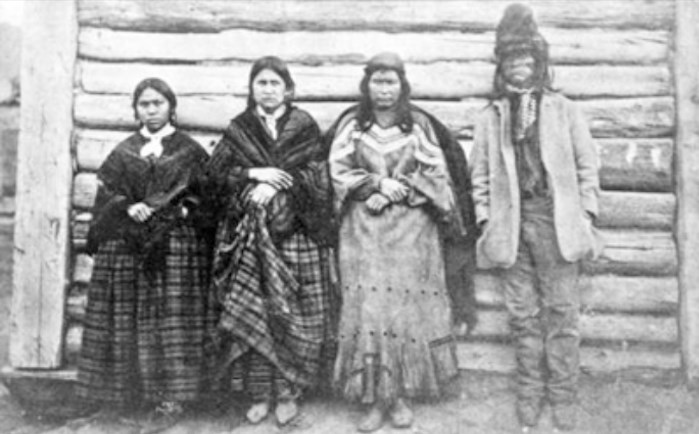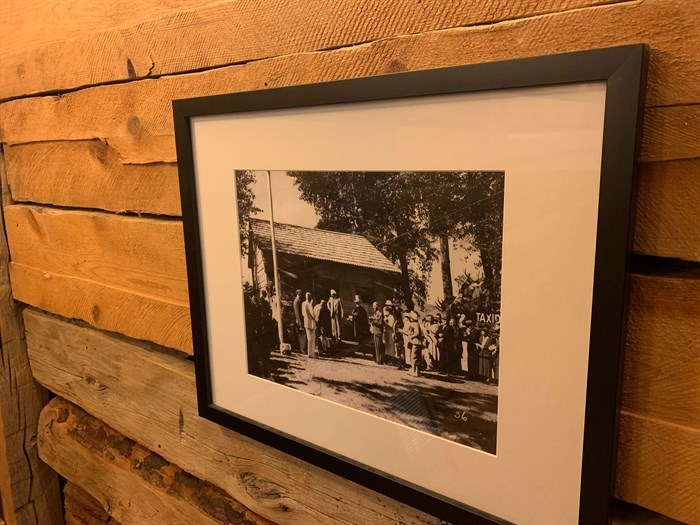
This is the home of Jean Baptiste Lolo (St. Paul) inside the Kamloops Museum.
(LEVI LANDRY / iNFOnews.ca)
January 14, 2024 - 6:00 AM
While a Kamloops street and nearby mountain are just two of the many tributes to Jean Baptiste Lolo, his actual origins are clouded in the mists of time.
His stature as a founder of the settlement that became the city of Kamloops is undeniable and he was recognized by Canadian Prime Minister Stephen Harper in 2012 with a national historic designation.
“Unfortunately, there is no indication that any descendants of Jean Baptiste Lolo were advised of this distinction in 2012,” Aaron Huthinson said in an email to iNFOnews.ca.
Hutchinson is helping organize a “gathering” of what could be as many as 300 descendants who will meet at Thompson Rivers University in June to talk more about the man who was known by a number of names, including St. Paul.

Jean Baptiste Lolo and family
Image Credit: Public Domain
“I have asked our local MPs and MLAs from both Kamloops and Williams Lake to attend our reunion on June 1st, 2024 to speak to the descendants about Lolo's contribution to British Columbia and present Phyllis Webstad with a plaque in Lolo's honour, on behalf of both the federal and provincial governments," Hutchinson wrote.
“Phyllis is the founder of Orange Shirt Day and she has also made significant contributions to reconciliation efforts and education about Residential Schools. Phyllis is also a direct descendant of Jean Baptiste Lolo.”
READ MORE: iN VIDEO: Orange shirts for National Day for Truth and Reconciliation came from Williams Lake
While some historical records refer to Lolo as a chief of the Shuswap and/or Kamloops Indians, he is generally considered to have been of Iroquois origin who travelled with the North West Company to Kamloops in the early 1800s and was never an official chief.
The ‘Paths of the Ancient Ancestors and the Descendants,’ by Donna Sweet, says that Lolo was Metis, the son of a French Canadian man and an Iroquois woman.
“One story has it he was found alone on the prairies by French white traders and raised in the Kamloops area,” she wrote.
Historical records indicate Lolo was born in 1798.
“He may have encountered David Thompson while working for the North West Fur Trading Company in Montana as early as 1810,” Sweet wrote. “Thompson recorded the assistance of a young North West Company hunter by the name of Lolo, who would have been 12 years of age, not impossible if he lost his parents somewhere along the way.”
Lolo, in the Chinook language, means lift up or carry, which fits.
One of the most comprehensive recounting of Lolo’s life was an article in the April 1939 edition of the BC Historical Quarterly written by George D. Brown Jr. of Kamloops and W. Kaye Lamb of Victoria, using extensive references and quotations from Hudson Bay Company journals written at the time.
“He is one of the very few Indians who, like Maquinna of Nootka Sound and old Kwah of the Northern Interior, have gained a place for themselves in the history of British Columbia on their individual merits, in contrast to the many who are known simply because they happened to be chief of a certain tribe and at a certain time,” they wrote.
“Yet, in spite of this, Lolo remains to a great extent a man of legend and mystery; and any written account of his life must resemble a mosaic, composed of scores of carefully chosen but fragmentary references.”
Sweet’s article says Lolo was baptised by a Catholic priest (Father Demers) as Jean Baptist Leolo in Kamloops in 1842.
READ MORE: How Europeans distorted the true names of Kamloops and the Okanagan
Lolo first appears in Hudson Bay Company records long before that baptism, in 1821, after it took over the North West Company.
In a Fort St. James District report for 1822-23, Lolo was described as a “native of Kamloops” and a Father Morice referred to him as “one of the leading Indians of Fraser Lake.”
“This casual reference quite possibly indicates his true origin,” Brown and Lamb wrote.
What is clear is that, from 1828 until his death in 1868, Lolo spent most of his life working out of Fort Thompson on the east side of the confluence of the Thompson rivers, living to the end of his life there after Fort Kamloops was built on the west side of the rivers in 1842.
“It is evident that Lolo served the Company in the triple capacity of interpreter, guide and trader and, even in 1832, he had attained a position far above that of the ordinary Indian servant in its employ,” Brown and Lamb wrote. “That position, coupled with his forceful personality, gave him great influence amongst the natives and it was undoubtedly for this reason that he began to be referred to loosely as an Indian chief.”
READ MORE: The true story of Grand Chief Nicola, told by his descendant
While he is credited with being a great help to the fur traders and instrumental in preventing conflicts – even open warfare – between the Europeans and Indigenous peoples, there is little in the commentary about what kind of a man Lolo was until he was visited by Lieutenant R.C. Mayne of the survey ship H.M.S. Plumper in May of 1859.
By that time in his life, Lolo was often incapacitated by ill health.
“In the centre room, lying at length on a mattress stretched upon the floor, was the chief of the Shuswap Indians,” Mayne wrote. “His face was a very fine one, although sickness and pain had worn it away terribly. His eyes were black, piercing and restless; his cheekbones high and the lips, naturally thin and close, had that white, compressed look which tells so surely of constant suffering. Such was St. Paul as the Hudson Bay Company called him.”
Some years before that, the account goes, Lolo (St. Paul) felt there was something wrong with his knee.
“Having no faith in the medicine men of his tribe and there being no white doctor near, the poor savage actually commenced cutting a way to the bone, under the impression that it needed cleansing,” Mayne wrote. “In time, at the cost, of course, of great personal suffering, he succeeded in boring a hole through the bone, which he keeps open by constantly syringing water through it.
“Although obliged to lie in his bed sometimes for days together, his sway over his tribe is perfect and, weak as he is, he rules them more by fear than love.”
Despite his illness and apparent weakness, Lolo later accompanied Mayne on a trip to Pavilion where their journey was blocked by a raging river. A log across it served as a bridge but it was partially submerged, making passage difficult and dangerous. A number of Lolo’s men tried to wade across the log to tie a rope to the other side. They were repeatedly swept off the log by the rushing water and had to swim for their lives.
“Breaking from us he (Lolo) was soon standing mid-stream, the rope in his hand, yelling to his men and swearing in a French jargon peculiar to himself with a zeal and originality that would have inspired the members of Captain Shandy’s troop in the Low Countries with admiring envy.
“Very much to our relief, as may be supposed, St. Paul succeeded in scrambling over the fragile bridge with the agility of a monkey and, the rope being made fast to the other side, we crossed with comparative ease."

Inside Lolo's cabin.
(LEVI LANDRY / iNFOnews.ca)
While originally referred to as Lolo in the Hudson Bay Company records, that got changed later to St. Paul, or even Captain St. Paul or Mr. St. Paul.
One of the chief factors at the fort, John Tod, is reported in the BC Historical Quarterly as saying Lolo was a “mission Indian” who preached about St. Paul and, therefore, was given that title.
Mayne, for his part, officially named Mt. Paul after Lolo.
There are at least six other name tributes to Lolo, including St. Paul Street, Paul Creek, Paul Lake, Lolo Creek, Lolo Lake and Lolo Mountain.
Lolo had an on-again, off-again relationship with the Hudson Bay Company in Kamloops whose records report Lolo “deserting” the Company in 1833.
There are no records of him for more than seven years until he turned up at the fort at Fraser Lake in 1841 that was in the charge of the “ruthless” William Thew.
”Upon some trivial pretext, Thew fell upon Lolo and gave him such a beating that, arming themselves with axes, the naturally peaceful villagers went in a body to the fort, a mile distant, broke open the gates and rushed on the establishment when the now fairly frightened autocrat came to a window and, begging for his life, threw down gifts to the mob, promising at the same time to make Saint Paul a chief and compensate him for the ill-treatment he had received, word which succeeded in calming the irritation of the natives and preventing further hostilities,” Father Morice is credited as writing by the BC Historical Quarterly.
READ MORE: Land acknowledgement? No, Okanagan bands want land back
“Later in life, he occupied the old fort (Fort Thompson) situated on the east bank of the North Thompson and Thompson intersect—he acquired horses and cattle and the land became his personal estate,” Hutchinson wrote.
When Governor James Douglas ordered the creation of the Kamloops Indian Reservation in 1862, the Hudson Bay Company claimed ownership of the 10 acres of land Lolo occupied at Fort Thompson.
Douglas overruled them and Lolo, upon his death, donated the land to the reserve. Lolo’s restored house survives inside Kamloops Museum.
Lolo lived out his days at Fort Thompson, leaving behind at least seven sons and four daughters, some of whom married Hudson Bay Company factors.
He mined for gold along Tranquille Creek and became a merchant, running up some debts with the Hudson Bay Company whose documents detail his apparent reluctance to pay off those loans.
The Company’s chief trader, Hamilton Moffatt, recorded Lolo’s death on May 15, 1868 at the age of 70.
Descendants of Lolo can ask to join the John Baptiste Lolo private Facebook group here where they will find details of the June gathering, many more stories of his life and his many descendants.
To contact a reporter for this story, email Rob Munro or call 250-808-0143 or email the editor. You can also submit photos, videos or news tips to the newsroom and be entered to win a monthly prize draw.
We welcome your comments and opinions on our stories but play nice. We won't censor or delete comments unless they contain off-topic statements or links, unnecessary vulgarity, false facts, spam or obviously fake profiles. If you have any concerns about what you see in comments, email the editor in the link above. SUBSCRIBE to our awesome newsletter here.
News from © iNFOnews, 2024